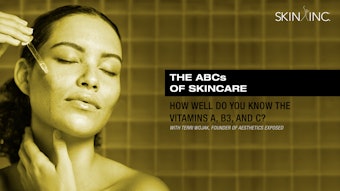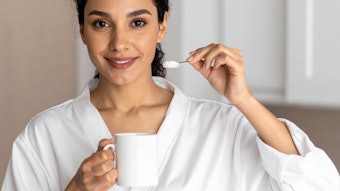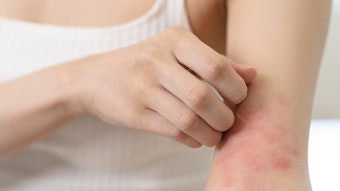
There is a new fad in skin care these days. Everywhere you look there are advertisements touting yet another new organic line. As concerns regarding the health of the environment continue to take center stage in the global conversation, these new lines are linking into this messaging, asking the consumer to believe organic products are not only safer to use than non-organics, but directly correlated to saving the environment.
While environmental stewardship is important, it is equally important to understand that organic product lines are not mutually exclusive to helping preserve the environment, nor are these lines always what you, as a skin care professional, should be recommending to your clients. To help keep your spa well-informed and getting the most out of your environmentally friendly practices, explore the background of formulating with botanical ingredients, what organic versus natural ingredients means at a biological level, and how you can thoughtfully make choices that will benefit your business and your clients.
Rare resources
Both natural and organic products incorporate botanical or herbal ingredients into their formulations. Usually these ingredients are purported to be the main therapeutic components. However, skin care practitioners should be careful to select botanical ingredients for their specific, desired beneficial effect based on scientific research and traditional medical knowledge founded on ethnobotany. A number of resources exist that can assist you in determining what activities the primary ingredients may have, such as the Natural Medicines Comprehensive Database.
Also, know some ingredients are obtained by wildcrafting, which is harvesting wild plants for commercial use. Unfortunately, this activity has brought certain plant species, such as American ginseng, to the brink of becoming endangered due to unregulated over-harvesting.1,2 Thus, skin care professionals should only support products that have renewable ingredients with sustained harvesting. A listing of these can be found with the Convention on International Trade in Endangered Species of Fauna and Flora at www.cites.org.
Safe standards
Botanical extracts are also much more susceptible to quality variations than synthetic products due to more factors affecting solubility, stability, pharmacokinetics, pharmacology and toxicity of the active ingredients. Some of these factors include:
- growing conditions of the plant,
- harvesting time, and care of botanical products during transport and storage,
- method of processing the plant for extraction of active ingredients, and
- in order to be of the highest quality, a plant must be healthy and disease-free.3
This means that the effectiveness or safety of a botanical ingredient is dramatically impacted by events such as those necessary to get the ingredient to market.
A natural or organic product does not always implicitly equal a safe product, either. Botanical-based products usually provide multiple functionalities and stable formulations of highly reactive ingredients. While it can be notoriously difficult to create efficacious and stable commercial formulations, botanicals containing multiples of these ingredients already exist in nature in stable mixtures that can be extracted.
For example, one of the world’s most deadly bioterrorist products is called ricin. It only takes about a teaspoon of ricin to kill up to 40,000 people if ingested via a city’s water supply or inhaled through a heating and cooling system. However, ricin is actually an extract from the castor bean, and another extract from the castor bean is azelaic acid, which is a top ingredient for treating rosacea. So this one plant produces two very different extracts with vastly dissimilar functionalities and safety. This example illustrates why skin care and spa professionals need to be mindful of and knowledgeable about what ingredients are in their products, as well as the ingredients’ safety and efficacy.
Essential effectiveness
A natural or organic ingredient at any concentration does not implicitly equal an effective product. Many of the more than 320 herbs used in skin care products are at concentrations below therapeutic ranges in order to minimize the risk of any unpleasant, adverse reactions. In other words, simply putting an ingredient into a formulation does not mean it will have any effect on the skin.
A major challenge to the clinical efficacy of any herbal extract is the delivery of therapeutic concentrations of the desired active ingredients across the stratum corneum permeability barrier in a functional state. Laboratory data of the function of an herbal extract cannot lead to the assumption of its effectiveness in treating human skin conditions with topical application. In fact, only one out of 350 new chemical entities with in-vitro data reach human prescription drug approval by the U.S. Food and Drug Administration (FDA), so producing an effective and safe non-prescription topical product requires complying with a known development path to overcome these challenges.
Regarding regulation
With this background information, it is now possible to look at what makes natural products different from organic products. The FDA does not have an official, enforceable definition for “natural” or “organic” products, and any references to natural through the FDA are in direct relation to food, not cosmetics. Additionally, there is no certification or regulation for using the term “natural.”4
However, the National Organic Program under the U.S. Department of Agriculture (USDA) oversees and certifies organic production and handling operations. According to the National Organic Program, “Organic crops are raised without using most conventional pesticides, petroleum-based fertilizers, or sewage sludge-based fertilizers.”5 Thus, organic skin care products must fall under the USDA guidelines in order to be considered organic, and extensive documentation must be maintained by all parties, including ingredient suppliers and product manufacturers.
There are three levels of organic as defined by the USDA:
- 100% organic. Products containing 100% organically produced ingredients, not counting added water and salt.
- Organic. Products that are at least 95% organic.
- Made with organic ingredients. These products contain at least 70% organic ingredients. The organic seal cannot be used on these packages.
Continuous questioning
To help distinguish true, scientifically based botanical cosmeceuticals from those that are not before making a decision on retailing or recommending any particular brand of products, skin care practitioners should be asking several questions. If the answers to any of the following questions are negative, it’s possible the products in question will have no therapeutic effect on the skin, and could even be potentially harmful. Make sure you are running through this or a similar checklist when you screen new products to use in your spa.
- Is the herb being used in other living, breathing organisms, such as a veterinary or dental medicine; as a part of traditional Asian or homeopathic medicines; or in food technology for mammalian exposure?
- Is the biologically active or therapeutic concentration range known and used inthe cosmeceutical?
- Is the formulation chemically and physically stable? The development of the formulation should include chemical, physical and photostability to ensure efficacy and that toxic metabolites are not formed. Stability with other interacting actives must also be achieved as with other ingredients necessary to product a cosmetically acceptable product.
- Does the botanical penetrate the stratum corneum permeability barrier in its active state at a high enough concentration to manipulate its target cell, organelle, enzyme, receptor or compound?
- When was the finished product manufactured? Freshness matters with herbal products. Active ingredients cannot defy the laws of chemistry. They begin auto-oxidation to some degree when manufactured, so they require chemical stabilization.
- Does the product really work in the skin? One of the only true ways a skin care practitioner can confidently recommend and sell botanical cosmeceuticals that are not based on a marketing ploy or voodoo science is by going through, or ensuring the product has gone through, prospective double-blind controlled clinical trials designated for the treatment of any or all parameters of photoaging compared to a placebo or an approved prescription product.
- Has the skin care practitioner thoroughly evaluated the product? When consulting with a skin care professional, clients assume any product has undergone the practitioner’s evaluation for efficacy and safety. They expect the practitioner to be a clearinghouse for accurate information for all skin products, prescriptions and treatments, so you need to have the knowledge to back this up.
Ready to rumble
With all the advertising and marketing dollars being spent on convincing you that an organic or natural product line is an imperative addition to your business, keep in mind your clients will assume you use similar criteria to establish which products are offered as is used to determine which cosmeceuticals to recommend and sell. An organic line may not always be a better option than a natural line. Knowing what to look for and what questions to ask will help you provide a safe and effective product regimen for your clients.
References
1. T Cornuelle, J Lenhart, Topical botanicals, Cosmetic Formulations of Skin Care Products. Taylor and Francis, New York (2006) 299–308
2. J Chamberlain, R Bush, A Hammett, Non-timber forest products, Forest Products Journal, 10–19 (1998)
3. L Skidmore-Roth, Herbs and Natural Supplements, 3rd ed Elsevier Mosby. Philadelphia (2006) xiii, xvii
4. L Heller, Natural will remain undefined, says FDA. Decision News Media. www.foodnavigator-usa.com/Financial-Industry/Natural-will-remain-undefined-says-FDA. Jan 4, 2008
5. USDA National Organic Program, www.ams.usda.gov/AMSv1.0/getfile?dDocName=STELDEV3004443&acct=nopgeninfo.











